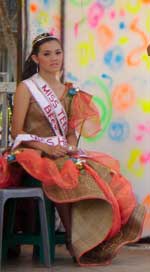BARIW: From fancy articles to fashionable attire

Banig as popularly known is a product from bariw leaves (common name pandan) scientifically known as Pandamus copelandii which belongs to the Pandanaceae family.
Production of banig or mat was pioneered in the historical province of Antique particularly in the Municipality of Libertad. Throughout the province, the word "mat" is closely associated with Libertad and this identity had been established which made a unique trademark on the existence of a town as mentioned by its Municipal Mayor, Hon. Mary Jean Te.
Bariw has a versatile economic uses; it can be made into mats, hats, baskets, slippers, handbags, portfolios, decors and other fancy articles which are long lasting and well crafted by the Libertadnons.
It is for this reason that the people keep on buying bariw products because they are favorite souvenirs which have reached almost all over the world -- Austria, Denmark, Canada, California, Seattle, America, Hongkong, China, Singapore, among others. Thus, for Libertadnons, banig is as staple as rice in their table. It is on this premise also that the Banigan Festival was born in year 2002 according to Mayor Te, and recently they again celebrated their 6th Banigan Festival 2006, a joint undertaking with their municipal fiesta with the theme "Banig: May Bili Pa Bala?" which signifies that no matter what changes may take place, Libertad will just remain a place it used to be as stressed by Mayor Te.
The Western Visayas Agricultural Resources Research and Development Consortium (WESVARRDEC) coordinators -- Dr. Raynaldo Dusaran, Prof. Pablo Española and Dr. Alicia L. Lustica and staff (Mr. Cleto Cordero and Joeven Tansi) and the Philippine Council for Agriculture, Forestry and Natural Resources Research and Development (PCARRD) representative Dr. Bessie Burgos were very happy to witness the Ms. Teen Banigan last March 13, 2006. This was the contest of 19 beauties representing the different barangays of Libertad. This pageant provided a venue to promote the famous bariw by making use of the product in the gown competition. All the lovely ladies were wearing bariw gowns in different styles and designs with some accessories made out of buri fiber, nito, abaca, chicken feathers, and other locally available materials.
With this celebration, it was worth promoting that bariw could not only be tapped as fancy articles but could even surpass the quality and style of other fashionable attire not only locally but even internationally.
With the high demand of this commodity, it is deemed necessary to rely not only on the existing bariw stand, but more plantations be established to sustain the growing demand of the material.
